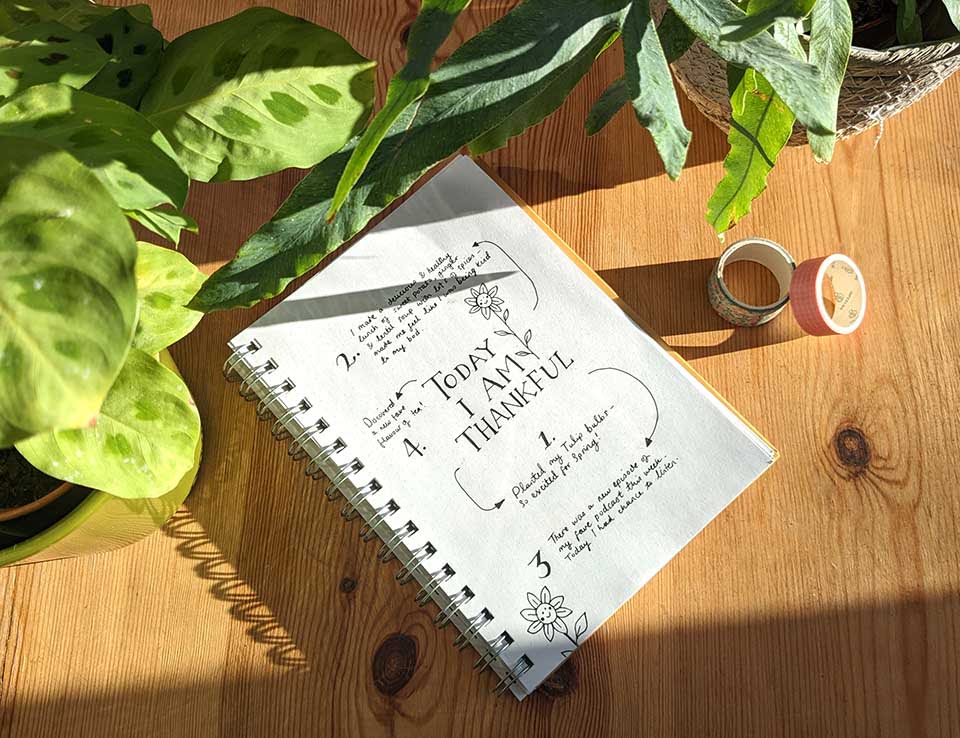
It can no longer be denied, 2022 is winding to a close. One part of the New Year’s celebrations I have always struggled with (apart from the fireworks, which are pretty, but scare my dog) is New Year’s resolutions. There are a hundred and one tips and tricks out there for how to set resolutions and make them stick. But I find the whole thing a little bit forced. Is the new year the best time to make changes? And why do I need a new me anyway? I find that during the cold, dark months all I really want to do is hibernate. Which isn’t really the sort of “new me” that New Year’s resolutions are supposed to inspire. So, this year, instead of a New Year’s resolution, I’m going to finish 2022 by starting a gratitude journal.
What is a gratitude journal?
Gratitude journaling is a popular practice in the field of positive psychology, which was defined by Martin Seligman, its founder, as the ‘scientific study of optimal human functioning’. In other words, studying what makes society and individuals live well and thrive. Keeping a gratitude journal involves taking ten to fifteen minutes a day to think about and write down three to five things you are grateful for. A gratitude journal can be very individual. You can focus on large or small events and experiences and either write short notes or focus for longer on the positive way you felt. However, the physical act of writing the gratitudes down is a vital part of the process, so it’s good to have a dedicated space to do this in.
What are the benefits of keeping one?
While most types of journaling are thought to be beneficial for mental health, there’s a fair amount of research being done into the science of gratitude journals more specifically. Researchers want to understand the effects this habit can have on the brain as well as individuals’ lives. In one study by Dr Robert A Emmons and Dr Michael E McCullough it was found that a group that kept a weekly gratitude journal felt more optimistic about their lives, exercised more regularly and had fewer physical ailments compared to two other groups, who kept a weekly record of neutral or negative events instead. The people in the group keeping gratitude journals were also more likely to make progress towards their goals over a two month period.
The researchers believe that practising gratefulness activates and releases dopamine and serotonin, neurotransmitters related to happiness, calmness and motivation, into the brain. They also found that the act of looking for events to be grateful for was more important than actually finding them, as it affected neuron density and heightened the effectiveness of the motor neurons and neural networks involved in grateful thinking. Essentially, it is like any habit – the more effort you put in, the easier it will become. Because of this, the beneficial effects of gratitude journaling can take a couple of months to become noticeable.
Despite this, it’s definitely worth sticking with it. According to research done at the UC Berkeley’s Greater Good Science Center, which focuses on the study of wellbeing through psychology, sociology and neuroscience, keeping a gratitude journal can also help individuals to have stronger immune systems. It can also help people to be more optimistic and form better relationships.

How to start your gratitude journal
The best way to start a gratitude journal is to have a dedicated space for writing your gratitudes. As well as a specific time to commit to it. This could be every other day instead of every day. But having a routine is helpful when establishing new habits and will allow you to put your best foot forward.
Some advice for gratitude journaling includes:
- Focus on your senses. Things you’ve enjoyed seeing, tasting, doing or hearing are all great gratitudes.
- Use visual reminders. A notebook with blank pages is perfect for adding your own doodles, illustrations or photos.
- Go for depth over breadth. Rather than finding as many gratitudes as possible, start with just one or two. Really focus on what they meant to you.
- Try subtraction. Thinking about what you would miss if it was removed from your life is an easy way to identify gratitudes you may have overlooked.
- Get personal and think outside the box. Try to think of what you are grateful for in your own life. Little or large, anything that has made you feel good can go in your gratitude journal!

I believe that the new year is not just a time to look ahead, but also a time to focus on what you’ve achieved over the past year. What are you grateful to have experienced or proud of overcoming? I’m planning to start my gratitude journal with what I am grateful for from 2022 as well as excitement for the opportunity of another year to fill with adventures and joy. Wishing you plenty to be grateful for in 2023.
